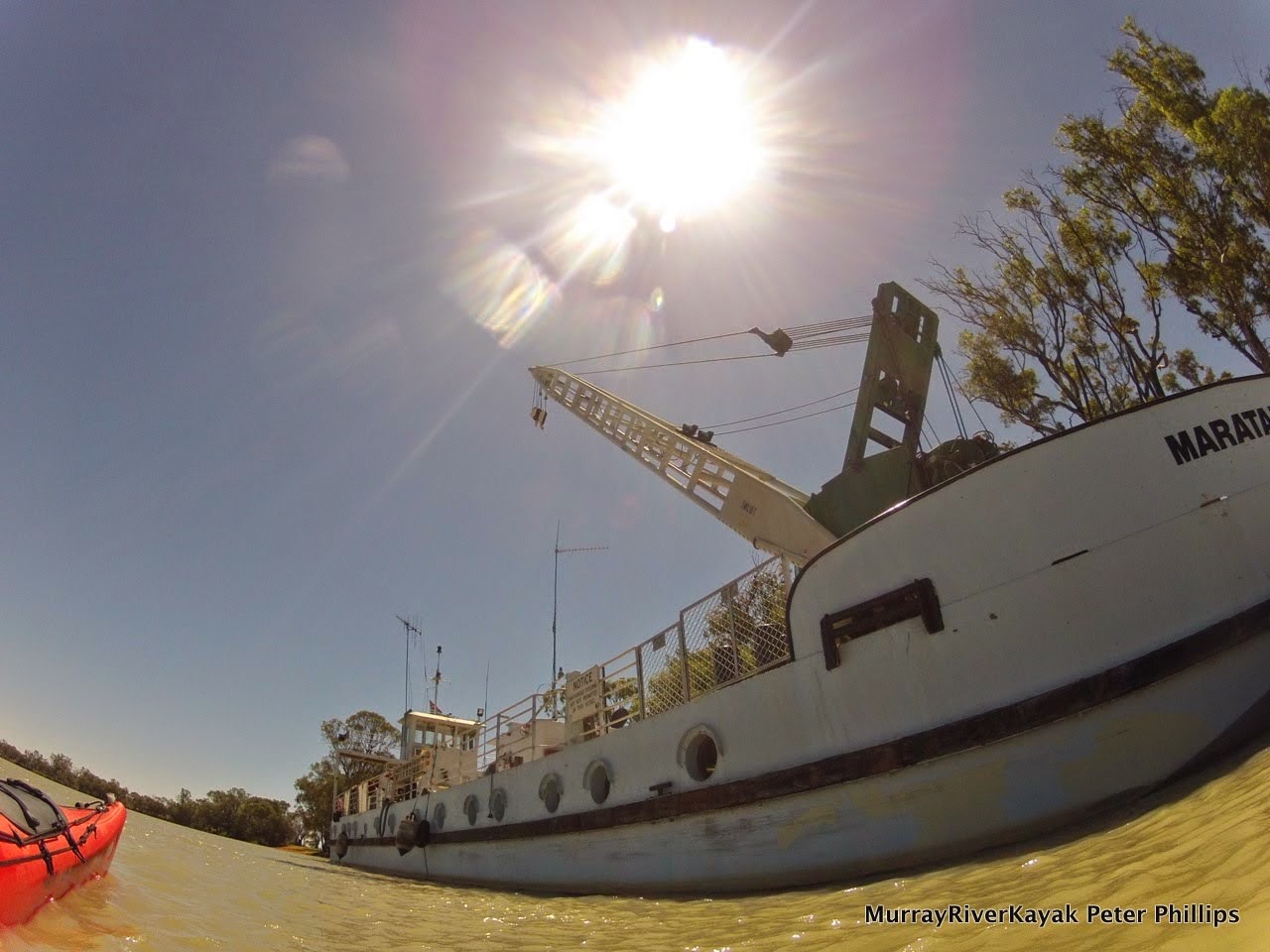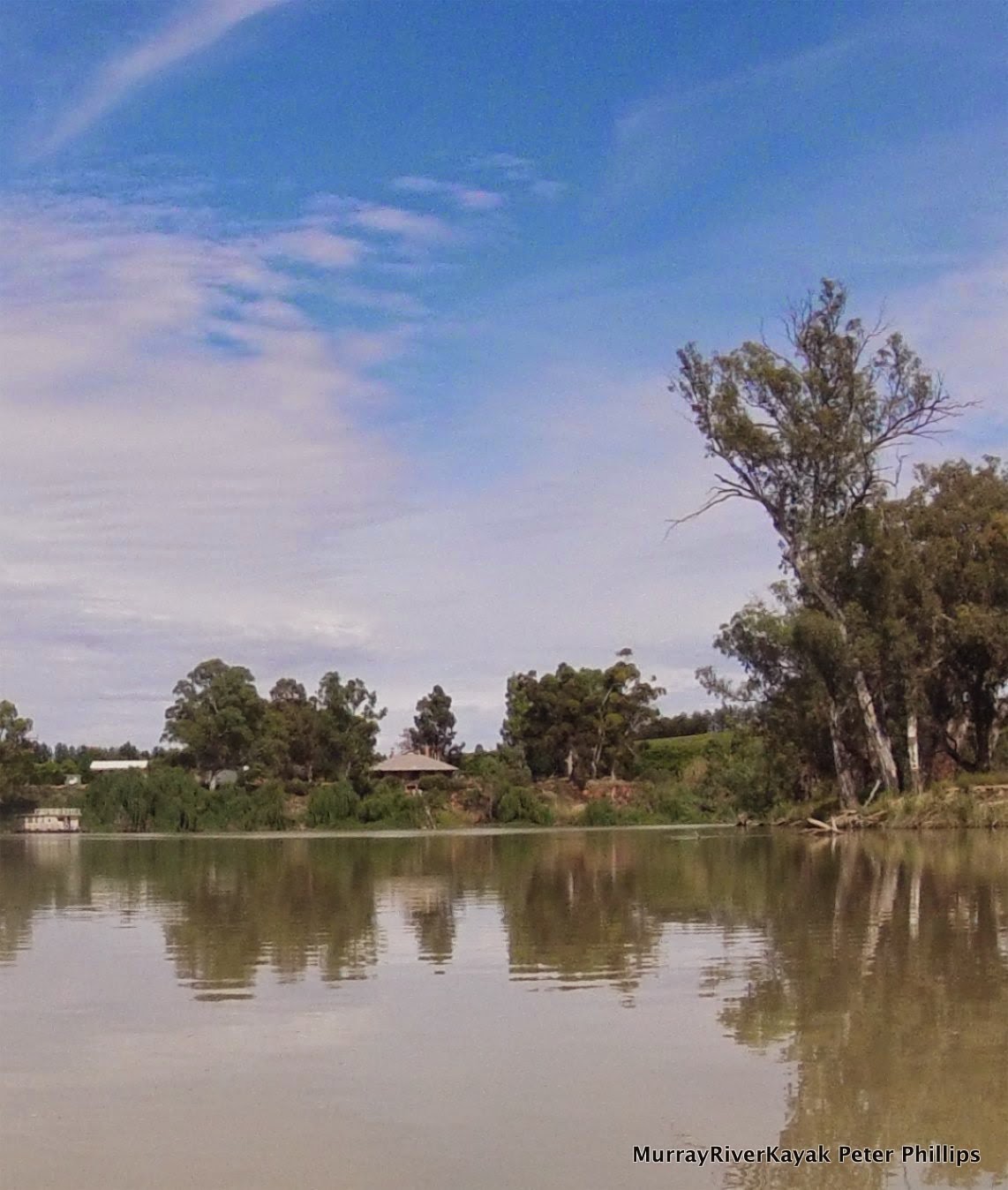Day 23: Monday 10/12
Renmark - Lock 5 and 4 - Rilli Island Conservation Reserve, Loxton.
River markers: 566 to 500 km from the sea.
Distance travelled today: 66 km.
The 8:30 am start was late for me, but most of the caravan park was still asleep. They can't have had a river to paddle down - yes that was it. This was the friendliest caravan park I had ever been in, as well as the cleanest. Not sure about cheap, but the experience is close to resort like. So, secure in their comfort people slept, whilst I packed and got ready to go. An elderly gentleman who had chatted to me the day before came down to wish me well. He was going to come back before I left, but then even in conversation, he kept forgetting things.
Being tired, I set myself a more modest goal of Lock 4, just 52 km today. I could get most of it done by lunch and cruise in the rest. I paddled steadily, in no particular hurry, lucky to have a good current - something I had not banked on at this end of the river. The flow from the Darling was helping. The current was about the speed it is at Echuca (about 1.5 km/hr); given that the water here is pooling between weirs, that is something. Enjoying the scenery and the waves from the wind (think positive).
 |
| Day 23: Afternoon sun on the river near Berri |
 |
| Day 23: Pulled up at the shady lawns at Martins Beach in Berri for some lunch. |
 | ||
|
 |
| This houseboat actually looks like one. |
I passed through two locks today, Lock 5 just 6 kilometres out of Renmark and Lock 4, 46 kilometres later. I shared the first lock with a couple who were travelling the Murray in a tinny. It was fast and well appointed, but given that a lot of their load was petrol, it was a good thing that neither of them smoked! They were off to Kingston for lunch. I later looked up where Kingston lay. It was about 140 kilometres away. No wonder they sped off. They would finish in Goolwa in about a week, they told me. This was interesting, because I expected only to take 2 or 3 days longer in my kayak. A lot of tinny travellers are fishermen. They like to whizz from place to place, but in the end spend a lot of time sitting still. Quite often the fishermen will see things that I haven't seen, because they have been still and quiet. As my two companions were not fishermen and had had enough of camping, i wondered where they might be spending their time. To their credit, when I arrived at lock 4, the lockmaster said he had been inspecting me. Two tinnies had said that a mad bloke in a kayak was still coming and to keep an eye out.
 |
| Day 23: Scar tree. The shape of the canoe was cut into the wood and then the sap wood was pried loose from the tree using wedges. This was then shaped and hardened using fire. |
There is so much to see on the Murray. It is not possible to write about it all the time, or to photograph or film it. It just happens all around you. I find each bend changes from the last and my friends who have paddled this stretch before tell me on seeing my photographs that it has changed so much since they came through. The bush changes with the seasons, in the early summer I am travelling through the gums are flowering and the air is full of the sounds of bees. At night frogs take over, happy to have reeds to hide in and rich mud nourishing the insects and larva they feed on. The trees still have birds sitting on nests, although most of the young have left. I saw a couple of young darters yesterday, their plumage white and downy. They had very fat tummies - full of baby carp no doubt. Unable to fly away, they dropped like stones into the water and did not resurface until I was gone. Ducklings were doing the same thing around Barham. It is amazing how well they can swim underwater being just a few days old.
 |
| Day 23: Dead tree reaching for the sky in front of cliffs near Berri. |
The river level changes too. Six weeks ago it was a metre higher. I can tell that on the island I am camped on tonight, the sand is still hardening. On the beaches, many young trees fall over in the big winds as this young soil, like the mud at my campsite in Murrabit, just has no strength to it. The shallow cutting coming in to Robinvale had been a raging torrent with rapids when Rose Fletcher paddled through in it in October. I don’t think the river is actually the same any two times you travel down it.
 |
| Day 23: Can anyone remember where I put my boat? |
I think that whenever and however one travels the Murray, so long as you spend enough time, you will see things. Today I saw a water rat emerge from its burrow. The first time I had even seen one do that. It snuck along behind the tree roots till it thought that I could not see it anymore. Swans leading me away from their young, protected in the shallow billabongs are a common sight. I get a thrill when they take off, their long necks stretched, legs racing to help build speed and to push off the water, their wings beginning to whistle as they build up air speed. And pelicans! No wonder it used to be a derogatory term to be called a pelican. I love them, but they are funny, and awkward. They begin their flight effort with strong two legged hops, thrusting their heavy bodies forwards and upwards, building momentum, assisting their huge wings. Then, in order to gain the height they need to clear the river red gums lining either side of the river, they need to turn in tight circles at least three times, all the time beating their wings strongly. All when they need not have taken off at all. My boat was no threat - but they got nervous - and then had to do all this work. They really must be at the limit of how big a bird can be. Yesterday, I saw a family a wedge tailed eagles, with the young ones in flight training. I thought they might be little eagles at first because of their size, but then I noticed the adults calling the shots.
Today's scenery continued to be punctuated by the most majestic cliffs. There were long straights and generous reaches, which, if into the wind called for patience. I passed through Berri and spent a cool restful lunch at Martins Bend, where the lawns are beautifully cared for and the camping is free. The caretaker, who lives on site, had a large cut-out Santa Claus and so many reindeer, each with their own name pulling them. How cool! I am a sucker for Christmas things and have been missing the lead up. I seem to be well ahead of schedule now, so getting back on time for Christmas with the family will not be a problem.
 |
| Day 23: River landscape near Berri. The constant water levels from the weirs help create ideal conditions for reeds to grow. |
Tomorrow I will aim for Kingston, or perhaps even to go through Lock 4, a journey of 64 and 69 kilometres respectively. The next location after that is the overland corner after 75 kilometres of paddling, but I don't know much about that at this stage.
Really enjoying the journey!
More from this expedition:
- Google+ Murray River Paddle Echuca To The Sea Photo Album
- Facebook Murray River Paddle
- YouTube Murray River Paddle
More information about topics from this page:
- Wikipedia: Renmark, Berri
- National Trust: Wilabalangaloo Reserve
- Rilli Island Conservation Park Management Plan
- Loxton Tourism: Campsites Map, Tourism info,
- Barry and Maureen Wright's River Murray Charts
- Environment Victoria: The Living Murray
- Ecology of Floodplain Lakes and Billabongs
- Geology: Murray Valley Geography (A geological timeline of the development of the Murray).
- Victorian Geology: Tectonic Framework of the Lower Murray. (from Red Cliffs).
- ABC Riverland SA: News and Community Events





























































